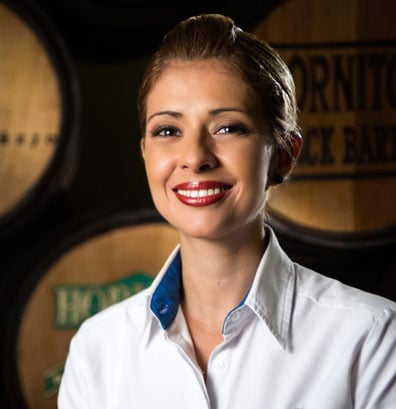
This is an interview of our coworker Carlos Beas Sandoval, Casa Sauza’s expert in raw material control. He tells us about his experience in this field, and about the details to consider during registration, administration and quality-control of raw materials.
What does the task of raw material control consist of?
"My job is to control Casa Sauza’s raw materials. We work with scales––basically making up the foundation of the tequila-making process. Our work consists of receiving every single raw material required for tequila-making, and recycling that raw material after it has been used. Some of these materials are as follows:
- Agave
- Combustible fuels
- All types of sugars
- Agave waste (bagazo)
- Bulk tequilas
- Tequilas for exportation
We also manage the following:
- Organic waste
- All disposables
- Agricultural waste
- Scrap materials
Raw material control is not only responsible for weighing raw materials, but also the disposable process of all waste, as well as agave control.
What is the control and registration process of agave?
We meet all the agave vendors at the Indian Ranch on a daily basis, where they wait their turn to speak with us individually and be directed to La Perseverancia: our tequila-making factory. All of the trucks that arrive must register on a list, in order to know how many transportation vehicles we have at the moment and therefore how much agave to assign to each vehicle during the 3 work-shifts that make up 24 hours.
The main challenge is to supply the tequila factory with just the right amount of supplies in a timely manner.
Supplying the right amount of agave requires strategic planning within the factory. The most experienced team-members have an annual program that plans how many tons of agave will be necessary to consistently produce tequila in a certain period of time. These team-members provide their annual report, including all the weekly schedules for agave receipt.
I have about 8 years of experience in this field, and what I’ve learned is that amount of agave received varies weekly, but doesn’t change too much from year to year. We manage around 300-400 tons of agave daily. Our capacity is established at 450 tons. As a result, we mill around 2,180 tons of agave per week.
The majority of our trucks carry about 20 tons. There are also smaller trucks that we use for less accessible pick-up places, and these trucks can typically carry around 10 tons each. We receive 7-8 trucks a day, coming out to around 24 trips maximum per day.
What are the control standards for raw materials?
Before accepting tequila into the plant, we review their documentation to make sure it is supported by an agave guide issued by the Tequila Regulatory Council (TRC). The Tequila Regulatory Council helps us certify that the agave we receive is part of the Tequilana Weber family, which is an agave that is harvested when ripe.
The control and management of Casa Sauza’s agave starts in the planting stage. We register all of our agave plantations with the TRC so that we know how many plants are ready for harvesting year to year, and so that we also have assurance that the materials arrive on time in perfect condition.
The Quality Lab is in charge of creating a growth analysis for each plantation. Once they have selected the plantations that will supply agave, there is a preliminary harvesting of 3-6 plants that go through TR analysis (total reduction of sugar) so that teams can make an informed decision regarding what quality tequila these particular plants can produce.
Each plantation is identified by a unique internal code, which provides us with general information so that we can easily carry out weighing the plant and allowing it entrance into the factory. Once we have weighed the agave, we unload it so that it can be ground. It is during the grinding process that we retrieve a sample to send to the Quality Lab for RT analysis. We can also collect a sample from the agave fruit by using a drill with a hollow, sharp auger to penetrate its hard shell into its inside. The material retrieved by the auger is then sent to the Lab for RT analysis, as well as other important data analysis like juice volume and predicted yield.
These are the basic points of documentation that help us identify, classify and register agave as soon as it arrives:
- Unique file in the weighing system (consecutive)
- CRT identification number for tracking/monitoring
- Date of entrance
- Plantation registration number
- Provider registration number
- Supplier order
- Owner of plantation
- Number of agave fruit
- Age of agave
- CRT file
Each bag of agave is identified and assigned a number that represents characteristics of the agave within. This consists of a visual inspection. The numbers represent the following:
- 1: Tender
- 2: Average
- 3: Ripe
- 3X: Very ripe
This provides important information for the laboratory analysis. After conducting the tests, the lab provides a report of RT results, which are then submitted to the CRT and shared with other general process management.
We also carry out hygienic practices in our area in order to assure general safety when moving raw material from process location to process location, to ultimately create the best final product. Another important aspect of our work is safety, which is why we consistently use our PPE (personal protection equipment) and follow the corresponding protocol in all aspects of our working responsibilities.
Safety in Areas of Raw Material Reception
At Casa Sauza, we have well-defined safety standards that require all transporters to show us documentation for all and any products and their contents.
In areas where agave is unloaded, it is important to consider risk factors for the raw material and the people handling it. Some of these risk factors are:
- Electric installations
- Dry and clean surfaces
- Assuring that there are no risks in the general environment
- Having anti-spill equipment and tarpaulins on hand
- Time and movement scheduling and management
Vehicles must enter the area in good conditions with orderly documentation, like driver’s license and registration. When vehicles enter, they must be guided to the unloading area with internal traffic regulations.
At Casa Sauza, we are well within basic safety parameters for both the products and our team-members.
How is working for Casa Sauza?
I have always enjoyed working at Casa Sauza. I first started in 1984 as a seasonal employee while I was a university student, and I supported work in many fields.
Then, from 1985 through 1986, I worked in the packaging process, bringing materials from Guadalajara to La Perseverancia factory in Tequila Jalisco. In 2009, I finally became a Agave Reception Control Technician, and later became manager of raw materials.
I am very proud to work at Casa Sauza, and very gratuitous to the company, where I learn so much from my coworkers just on a day-to-day basis. We can constantly share experiences and learn from each other in this cordial working environment. Those of us who work at Casa Sauza work with pride for what we do.
The most important thing about working here, though, is that I can do my job with purpose––a purpose that encourages me to deliver the best work I am capable of, contributing to the excellence and quality of our tequilas. We do all of this to provide the best tasting tequila for our most demanding clients, because the grace and harmony of our working environment strengthens the quality of our brands.
I feel proud to work for Casa Sauza, and after all of these years, I can truly say it is like my second home."
Come and visit Casa Sauza and see for yourself how the modernization of our production processes delivers the purest tequila that you will find in the market.
.png?width=50&height=50&name=10.CS-Redondo%20(1).png)
 Karina Sánchez
Karina Sánchez